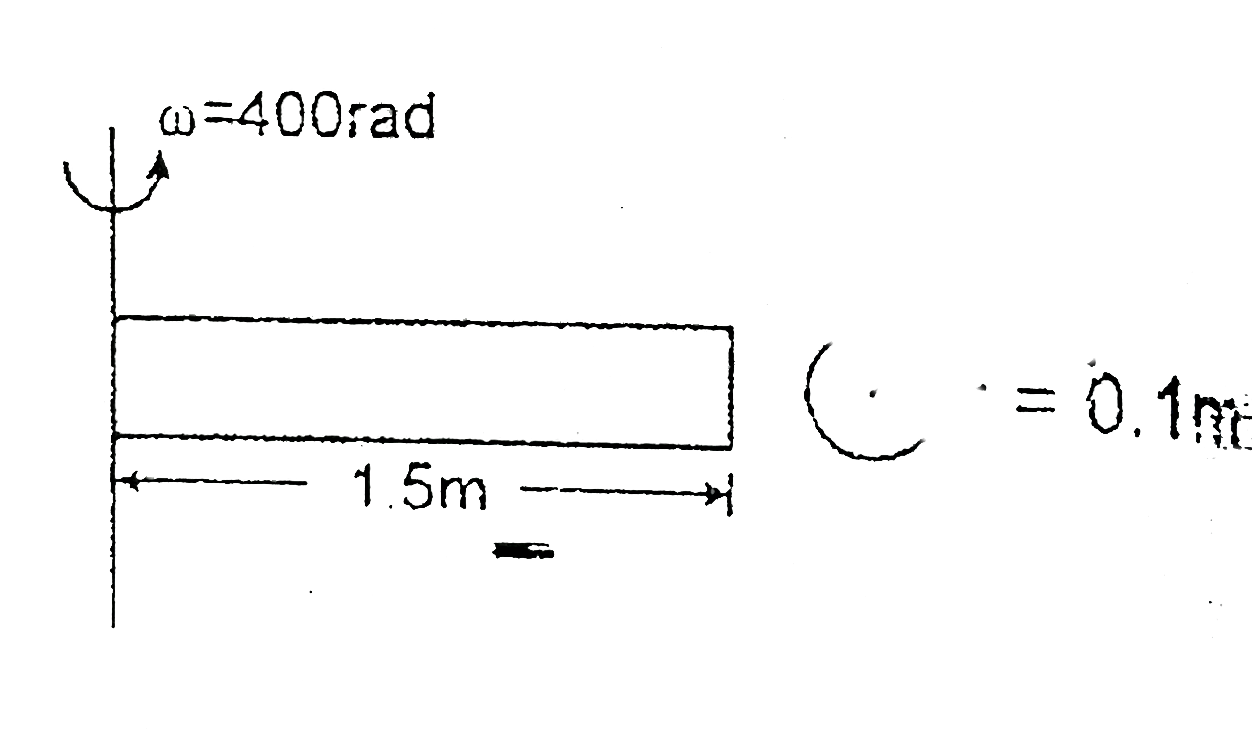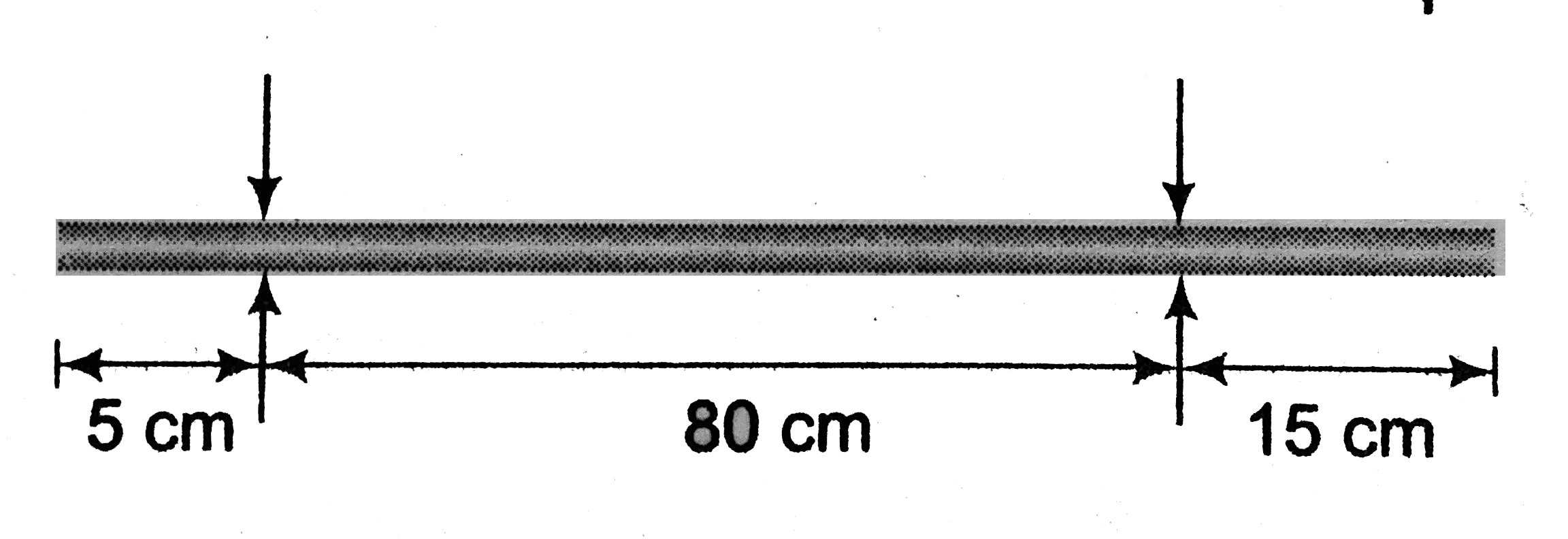A metallic rod of length 1m has one end free and other end rigidly clamped. Longitudinal stationary waves are set up in the rod in such a way that there are total six antinodes present along the rod. The amplitude of an antinode is 4×10−6m. young's modulus and density of the rod are 6.4×1010N/m2 and 4×103Kg/m3 respectively. Consider the free end to be at origin and at t=0 particles at free end are at positive extreme.
The magnitude of strain at midpoint of the rod at t=1sec is
11√3π×10−6
11√2π×10−6
10√3π×10−6
10√2π×10−6
The correct Answer is:B
To solve the problem, we need to find the magnitude of strain at the midpoint of a metallic rod at a given time. Let's break down the solution step by step.
Step 1: Understand the wave setup
The rod is 1 meter long with one end free and the other end clamped. There are 6 antinodes present along the rod. The amplitude of the antinode is given as A=4×10−6m.
Step 2: Determine the wave equation
The stationary wave in the rod can be described by the equation:
y(x,t)=Acos(kx)cos(ωt)
where:
- k is the wave number,
- ω is the angular frequency.
Given that there are 6 antinodes in a 1 m rod, the distance between successive antinodes is 16m. Thus, the wave number k can be calculated as:
k=nπL=6π1=6πrad/m
The angular frequency ω can be determined using the speed of sound in the rod, which is given by:
v=√Yρ
where Y=6.4×1010N/m2 (Young's modulus) and ρ=4×103kg/m3 (density).
Calculating the speed v:
v=√6.4×10104×103=√1.6×107≈4000m/s
Now, we can find ω:
ω=vk=4000×6π=24000πrad/s
Thus, the wave equation becomes:
y(x,t)=4×10−6cos(6πx)cos(24000πt)
Step 3: Find the strain
The strain ϵ in the rod can be calculated using the formula:
ϵ=∂y∂x
Differentiating the wave equation with respect to x:
ϵ=∂∂x(4×10−6cos(6πx)cos(24000πt))
Using the product rule:
ϵ=4×10−6(−6πsin(6πx)cos(24000πt))
Thus,
ϵ=−24π×10−6sin(6πx)cos(24000πt)
Step 4: Calculate strain at midpoint and time t=1s
At the midpoint of the rod, x=12:
ϵ=−24π×10−6sin(3π)cos(24000π⋅1)
Since sin(3π)=0:
ϵ=0
Final Result
The magnitude of strain at the midpoint of the rod at t=1s is:
ϵ=0
The rod is 1 meter long with one end free and the other end clamped. There are 6 antinodes present along the rod. The amplitude of the antinode is given as A=4×10−6m.
The stationary wave in the rod can be described by the equation:
y(x,t)=Acos(kx)cos(ωt)
where:
- k is the wave number,
- ω is the angular frequency.
k=nπL=6π1=6πrad/m
v=√Yρ
where Y=6.4×1010N/m2 (Young's modulus) and ρ=4×103kg/m3 (density).
v=√6.4×10104×103=√1.6×107≈4000m/s
ω=vk=4000×6π=24000πrad/s
y(x,t)=4×10−6cos(6πx)cos(24000πt)
The strain ϵ in the rod can be calculated using the formula:
ϵ=∂y∂x
Differentiating the wave equation with respect to x:
ϵ=∂∂x(4×10−6cos(6πx)cos(24000πt))
Using the product rule:
ϵ=4×10−6(−6πsin(6πx)cos(24000πt))
Thus,
ϵ=−24π×10−6sin(6πx)cos(24000πt)
At the midpoint of the rod, x=12:
ϵ=−24π×10−6sin(3π)cos(24000π⋅1)
Since sin(3π)=0:
ϵ=0
The magnitude of strain at the midpoint of the rod at t=1s is:
ϵ=0
Topper's Solved these Questions
Similar Questions
A metallic rod of length 1m has one end free and other end rigidly clamped. Longitudinal stationary waves are set up in the rod in such a way that there are total six antinodes present along the rod. The amplitude of an antinode is 4×10−6m. young's modulus and density of the rod are 6.4×1010N/m2 and 4×103Kg/m3 respectively. Consider the free end to be at origin and at t=0 particles at free end are at positive extreme.
The equation describing stress developed in the rod is
View SolutionA metallic rod of length 1m has one end free and other end rigidly clamped. Longitudinal stationary waves are set up in the rod in such a way that there are total six antinodes present along the rod. The amplitude of an antinode is 4×10−6m. young's modulus and density of the rod are 6.4×1010N/m2 and 4×103Kg/m3 respectively. Consider the free end to be at origin and at t=0 particles at free end are at positive extreme.
The equation describing displacements of particles about their mean positions is.
View SolutionA metallic rod of length 1m is rigidly clamped at its mid point. Longirudinal stationary wave are setup in the rod in such a way that there are two nodes on either side of the midpoint. The amplitude of an antinode is 2×10−6m. Write the equation of motion of a point 2 cm from the midpoint and those of the constituent waves in the rod, (Young,s modulus of the material of the rod =2×1011Nm−2 , density =8000kg−m−3). Both ends are free.
View SolutionCalculate the speed of longitudinal wave in steel. Young's modulus for steel is 3×1010N/m2 and its density 1.2×103kg/m3
View SolutionCalculate the speed of longitudinal wave in steel. Young's modulus for steel is 3×1010N/m2 and its density 1.2×103kg/m3
View SolutionA rod of nickel of length l is clamped at its midpoint . The rod is stuck and vibrations are set up in the rod . Find the general expression for the frequency of the longitudinal vibrations of the rod . Young's modulus and density of the rod is Yandρ , respectively.
View SolutionA metallic rod of length 1 m, young's modulus 3×1011Nm−3 and density is 7.5×102kgm3clamped at its middle. Longitudinal stationary vibrations are produced in the rod with the total number of displacement nodes equal to 3. The frequency of vibrations is
View SolutionGiven Y=2×1011N/m2,ρ=104kg/m3
Find out elongation in rod.

View SolutionA metal rod of length 1m is clamped at two points as shown in the figure. Distance of the clamp from the two ends are 5 cm and 15 cm, respectively. Find the minimum and next higher frequency of natural longitudinal oscillation of the rod. Given that Young's modulus of elasticity and density of aluminium are Y=1.6×1011Nm−2 and ρ=2500kgm−3 , respectively.

View SolutionA rectangular metallic bar one metre long, one cm deep and one cm broad is placed on a smooth table. The Young's modulus and modulus of rigidity of metal of the bar are 2×1011N/m2 and 8×1010N/m2 respectively.
If the bar is rigidity clamped at one end is pulled at the other end with a force 5000 N applied normaly to its end cross-section, calculate the elongation of the bar and the work done in elongating the bar.
View Solution

